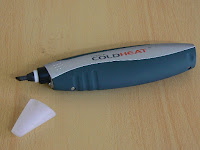
After upgrading to Gutsy Gibbon and reclaiming and saying goodbye to Vista partition. Time for some fun. Giving Android a trial run. SDK download and setup instructions here
that was smooth and easy, no hiccups.







 ed with a fair amount of info about your batteries. Then, right click and view the power history. It shows how much power your laptop has been sucking up in watts plotted against time since the system started.
ed with a fair amount of info about your batteries. Then, right click and view the power history. It shows how much power your laptop has been sucking up in watts plotted against time since the system started.







 I narrowed down my search to Hakko FX 901 and Weller's BP645. Both are still no replacements for true "corded" soldering irons but are good enough for ordinary PCB work. I recommend you use rechargeable NiMH batteries. Weller's is smaller and uses 3 AA batteries where as Hakko uses 4xAA. Hakko is prettier. You can find good "objective" reviews here and here.
I narrowed down my search to Hakko FX 901 and Weller's BP645. Both are still no replacements for true "corded" soldering irons but are good enough for ordinary PCB work. I recommend you use rechargeable NiMH batteries. Weller's is smaller and uses 3 AA batteries where as Hakko uses 4xAA. Hakko is prettier. You can find good "objective" reviews here and here.


